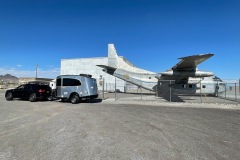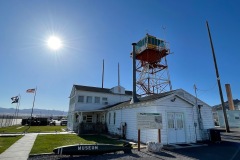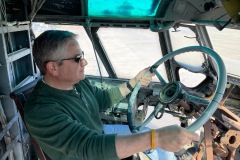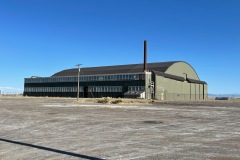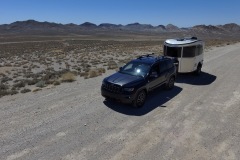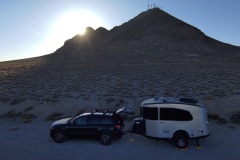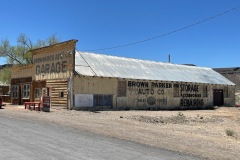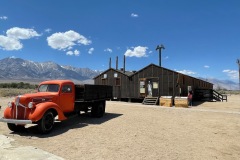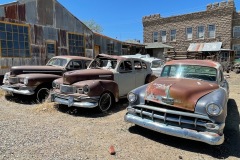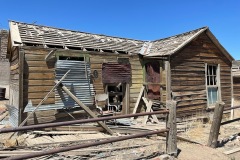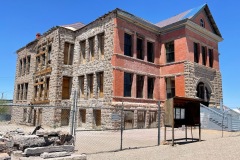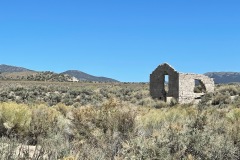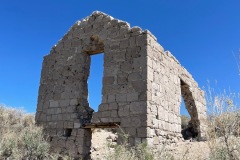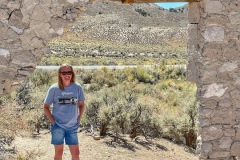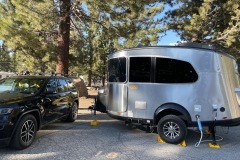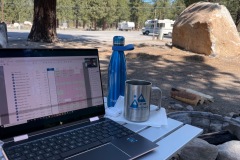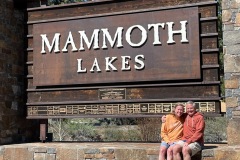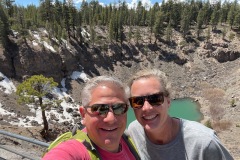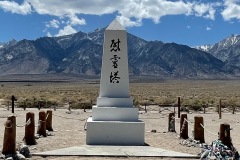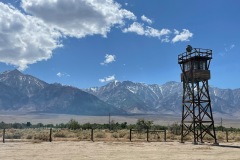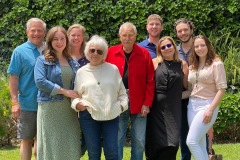Monday May 3
After working earlier in the day, we picked up Al at about 3:00 from Full Service Storage and headed out toward Wendover, Utah. Our inclination was to head East on the 201 and eventually to I-80 West, but Google Maps had us take the 201 West until it re-joined the 80 close to the Salt Lake Marina. This was a new route for us, and David enjoyed looking at all the buildings and equipment that are related to the processing of copper from the nearby Bingham Canyon mine.
Thanks to Harvest Hosts, we arranged to stay overnight in the parking lot of the Historic Wendover Airfield Museum. What a cool place! The Wendover airfield was a military base during World War II where bomber crews trained for deployment in the European and Pacific theaters, but it is probably best known for being the place where bombardiers were trained in the use of the Norden bombsight and where the B-29 crews trained and prepared for dropping the atomic bombs that eventually brought about the end of the war.
When we initially arrived, we stopped in front of one of the prop planes from Con-Air to take a cool photo of the Basecamp and Grand Cherokee with the plane in the background, and then we found a perfect and level spot to park for the night. Later on we had a chance to go inside the C-123 and noticed that the flight controls had been removed and replaced with a bus/truck steering wheel, accelerator, and brake so that it could be driven around on the ground for various scenes in the film.
The museum is closed on Sunday, Monday, and Tuesday, so we couldn’t visit. However, the museum and its volunteers, along with local businesses and others are working to restore and preserve the history of the airfield. They’ve placed informative signs all around the base letting visitors know about the history of each spot, and they have a smartphone app with even more information. Despite warnings that the tour could be, “quite lengthy if done on foot,” we walked nearly the entire length of it starting with the restored control tower.
The tower is about 24 feet square at its base and rises to a height of nearly 60 feet. Now let me tell you this: Sixty feet may not sound like much when you read it in a journal, blog, or on a sign, but once you climb up there and walk around on the expanded metal (read: see-through) platform, it can be quite unnerving even for those who aren’t acrophobic.
Donna has acrophobia, but she made it up there and even seemed to (somewhat) enjoy it. Her tip is to tell yourself that you’re on The Amazing Race and that if you climb to the top you will win a million dollars. What she should have done is told herself that she would win another million dollars for making it back down to the ground because going down seemed quite a bit more stressful than going up. Nevertheless, we got a good picture up there and isn’t it all about the ‘gram anyway?
We took about 90 minutes walking all around the airfield, reading the signs, taking photos, and just generally enjoying the experience. Among the interesting sights was the Enola Gay Hangar, now being restored, which was specially built to house B-29s like the Enola Gay and Bockscar. We also saw the hospital complex, barracks, and dining hall (the walls are said to have squadron patch art from all the airmen that stayed there). David also spotted plenty of civilian and military aircraft using the airfield for training, and he managed to ID an A10, several KC135s, and several F35s doing flybys and touch-and-goes.
Dinner this evening was a charcuterie board and some wine, while watching streaming media including The Rookie and The Handmaid’s Tale. Since we were the only ones in the parking lot, it was a mostly quiet night, except for the dirt trucks that steadily rolled past, the ranchero music a couple of buildings away, and the helicopter that flew by in the middle of the night.
Tuesday May 4
Neither of us took the week off from work, so mornings on this trip (including this morning) were spent working. To prepare for this, we used several camping-specific apps (Campendium, The Dyrt, Harvest Hosts) as well as the mobile coverage maps in the Gaia GPS app to be as sure as possible that we would have a strong signal for cellular Internet and/or good WiFi. Stay tuned to the end of this trip log to find out what we learned and what we plan to do on future trips.
Once our work was done, we left a donation for the museum through their app, met the next Harvest Host members pulling in for the night with their dog and huge rig, and then headed out on the road to Tonopah, Nevada.
The drive to Tonopah was a bit more than 5 hours on lonesome highways with very few other vehicles. It was a long, boring, and very unexciting drive punctuated by the occasional nature breaks or feed zones (as they say in the pro peloton). Other than that, it was just endless ribbons of desert highway.
Our plan for the evening was to camp overnight at the dispersed camping area on Bureau of Land Management (BLM) land just outside of town. Despite that, and perhaps as a distraction during the drive, we contemplated staying at other boondocking sites just off the road before reaching Tonopah, but as we approached each one we found little or no cell service for tomorrow’s workday and continued down the road.
Many of the reviewers on Campendium made it sound like accessing the dispersed camping area was difficult or confusing, and that we would have constant road noise from nearby Highway 95. None of that was true.
Access to the site is a dirt road that splits in three near its entrance. We followed the advice of helpful online reviewers and took the road farthest to the left and had absolutely no issues at all. The three branches merge into one after about 25 yards and the road widens quite a bit before heading up a small hill at which point it becomes quite narrow. We passed one small RV with all of its windows covered and went another 100 yards to a site with a nice view just before the road narrows. Once there, we leveled the trailer, took some drone footage of the setting sun (after obtaining FAA approval since this is within the airspace of the nearby Tonopah airport), and started preparing tonight’s meal of Barbacoa beef, strawberry margaritas, and homemade margarita cheesecake.
At some point in the early evening, a camper van passed us and headed up and over the hill on the narrow road. We never saw them again. As for the RV 100 yards down the road, Donna is convinced that it is abandoned, or at least currently uninhabited.
Oh yeah, and remember the aforementioned cacophony from Highway 95? David described the sound in our subsequent Campendium review as, “an infrequent barely audible whisper of vehicle noise.”
Wednesday May 5
After a restful evening, we awoke and started to make breakfast. After opening the window shades, something caught David’s eye. It turned out to be a well-fed coyote that was chasing, but not catching, its prey. The coyote then continued to lope along through our site, seemingly unfazed by our presence.
The cellular Internet connection at this so-called, “boondocking,” site was really good so we set up our table and both went to work inside and outside the Basecamp. Once we completed our tasks for the day, we drove out toward the highway with the drone following us for what David said was good B-roll.
Just before we headed out of town Donna received a call and needed to do a little bit more work. We figured if we drove into downtown Tonopah we would find good Internet, but what we found instead was absolutely no cell service, at least on the T-Mobile network. So it was back to the BLM land so that Donna could complete her workday before we headed out on the road.
It was then that we decided we might need to investigate a Verizon hotspot so that, between the two cellular providers, we might hopefully always be able to get our work done from the road.
As we drove back toward the BLM land we took time to see the sights in Tonopah, reminding ourselves why we decided not to stay overnight here with our then elementary school aged kids about 20 years ago. As it was then, Tonopah is a depressing, seemingly dying little town that would make a great setting for a creepy Stephen King novel about clown motels, mine shafts that double as the burial grounds for the victims of homicidal former drillers or muckers, and turn-of-the-century hotels haunted by the widows of silver barons.
Speaking of ghost towns (or soon-to-be ghost towns), our next stop was the town of Goldfield. Like the town in that Jimmy Buffett song, Goldfield is another, “dying little town.” A boomtown during the gold rush of the early 1900s that once boasted thousands of residents, today there are fewer than 200 souls in permanent residence.
Much of the town has been or is being preserved, and many of the buildings are numbered to make it easy to read about the history in the pamphlet available everywhere in Goldfield. David enjoyed the abandoned feeling of the town, but Donna felt that it was just sort of sad.
Just outside of town is The International Car Forest of the Last Church, a field where two artists worked in concert to plant various cars, buses, and other motor vehicles in the desert. We had intended to visit, but the dirt road in and out looked a bit dicey for anyone pulling a trailer, so instead we parked on the main street in front of what appeared to be the only open café, and walked around town ending our tour at the haunted Goldfield Hotel. Just before we rolled out of town, we made some lunch and then headed toward Mammoth.
Just before we hit the California border, David spotted some ruins on a hill beside a pullout, so he abruptly brought us in for a landing so that that we could get out and explore.
The marker there told us that this had been the site of Palmetto, a silver boom town from the 1860s that once was a town of 200 tents, but miners drifted away in 1906 leaving these ruins. The name of the town comes from the fact that some of the first residents mistakenly thought that Joshua Trees were related to Palm Trees.
David took some nice photos here and he even poked his head inside one of the mine shafts for an eerie look into the past.
The road between Palmetto, Nevada, and Bishop, California, is Highway 168. On a map, it looks like your typical winding road and seemed innocuous enough to these RV newbies. We would soon find out how important a few extra minutes of Internet route planning can be.
As we approached Westgard Pass we spied a warning sign that said something about how the route was not recommended for long vehicles, especially semis more than 30-feet from kingpin to rear axle. That didn’t sound like a warning that applied to us, so we continued ahead. When we saw another warning sign indicating that there was a one-lane section of road up ahead, we discussed how quaint that was and thought nothing further of it.
Then the steep climb began.
Then the twisty, hairpin turns began.
And both continued for miles on end.
The Jeep and its driver managed the road well, although the driver’s knuckles looked a bit white at some points and the passenger was seen to be smiling a bit nervously all the while reinforcing what a good job the driver was doing.
As the one-lane portion of the road approached, both driver and passenger were feeling confident and at ease. As the descending road narrowed down to a single lane everything looked clear. And that was when we saw the 18-wheeler heading toward us in the opposite direction. Considering that uphill traffic always has the right-of-way, David started to back up the trailer, completely forgetting everything he had learned about backing a trailer and looking (and feeling) like a total n00b. He eventually got far enough back for the truck to pass with inches to spare. And that’s when the second truck appeared right behind the first.
The rest of the drive on the 168 was uneventful enough, despite some more steep turns and downhill grades. Thank heavens for trailer brakes!
Eventually, we made it onto our old friend Highway 395, just north of Big Pine, and headed toward Bishop. Along the way, we made a dump stop at the Arco station in Bishop (free with just a donation to the local high school), and soon arrived at the Mammoth Lakes RV Park.
As soon as we got parked and situated in our spot, we got back in the Jeep to tour around Mammoth and look for food.
We were really anxious to explore Mammoth since we hadn’t been there in what we estimated to be about 25 years. We both spent a great deal of time in the Mammoth Lakes area when we were growing up. David’s family used to go fishing frequently at June Lake, and he spent school breaks skiing in Mammoth with his friends before he met Donna. Meanwhile, Donna’s family had a condominium in Mammoth from the time she was in Elementary School and after we met we would go to the condo with Donna’s family and/or with friends. And, of course, during David’s career in the bicycle industry we spent plenty of summer time in Mammoth attending (and participating in) mountain bike races.
In some ways, Mammoth hasn’t changed but in others it has changed a lot. For instance, the ski resort’s parent company (Interwest) built a “village” at the corner of the main road and Minaret Road that David said reminds him of Whistler (what a coincidence since Whistler is also owned by Interwest). The village includes food, lodging, and retail establishments and a gondola to take skiers up to Canyon Lodge (née Warming Hut 2). Plans for the gondola were chalked up to heresay and rumor back when we were teens, so it is nice to see it come to fruition.
One way the town hasn’t changed is in adopting to visitors with food allergies or restrictions. After visiting and calling more than a reasonable number of restaurants in town, we were unable to find any gluten-free options other than the usual, “we can make you a salad and leave off the croutons.” So we ended up at another old haunt, Vons supermarket, where we purchased a roast chicken, mashed potatoes, and the fixings for a wedge salad (stay tuned… these wedge salads are going to be a recurrent them in this blog).
Back at the RV park we realized that we were in the “winter” area which is an asphalt lot with dirt areas with fire rings adjacent to each spot, as compared to the “summer” spots which are much more “foresty,” with dirt spaces for cars and RVs plus green areas with fire pits. Because of the pandemic, the park has removed the picnic tables from all of its spots. We also noticed that there were plenty of people populating the summer spots so we didn’t quite understand why we were in the less scenic area.
We also noticed (how could we miss it?) that the site across the lot from us is a rented camper that David described as being populated by “bros.” The bros turned out to be 6 or 8 20- or 30-something Russian-speaking friends who enjoyed two things: smoking marijuana, and loud, awful music (I know, “if it’s too loud, you’re too old”), although it seemed like they only listened to 20 or 30 seconds of each track.
Thursday May 6
After a quiet evening in Mammoth (phew, the bros understand the meaning of the term quiet hours (тихие часы, for those bros who may still be wondering)! It was back to work again. David had a 3-hour Zoom meeting, which he took al fresco, and Donna did her usual work with two or three laptops in the Basecamp.
Work completed for the day, we packed a lunch for a planned tour of the Mammoth Lake Scenic Loop and a visit to June Lake.
Surprisingly, neither of us could remember have been on the Mammoth Scenic Loop in the past, so when we saw a turn off to the Inyo Craters, we took the turn and ventured off road for about a mile to the parking lot. The sign said it was a 1.6 mile easy round-trip loop hike to the craters, so we hiked in with the intention of lunching and droning when we got there, but it was too windy. We marveled at the craters and the deep blue water within them, took a few photos, and then continued back down the loop to the car, where we dined on our sandwiches and chips. Sated, we got back in the car and headed toward June Lake.
David says June Lake is a time capsule, with virtually no changes from his youth including Ernie’s Tackle Shop (where his family would buy bait and tackle), the Boulder Lodge (where his family used to stay), and the Tiger Bar (who knows what a family was doing there?!?).
After our drive through June Lake, we headed back toward Mammoth to pay a visit to Donna’s family’s former ski condo, after a pit stop first for a mid-day caffeine fix at Starbucks (that wasn’t here 25 years ago!) and to Schat’s Bakery for cheese bread (David never visited without bringing some home for his mom).
When it was time for dinner, we decided we would order a steak and baked potato from The Mogul, figuring it would be a safe GF option. Best laid plans… When David called to place the order, they told him that only the servers cook the food and no one could cook the order for us. Go figure.
We had read that a local Mexican restaurant called Roberto’s (not the San Diego version) could do gluten free meals, so we went there, were told that anything not on a flour tortilla was GF, and we placed our orders – Carne Asada tacos for Donna, and DUCK burrito for David. The food was really good and very plentiful. We figured that there was enough food for at least 4 people, which we ate back at Al where we watched, Stowaway. Food was GREAT, movie was NOT.
Friday May 7
Today was another workday, so we worked until mid-day, took some photos at the Welcome to Mammoth sign, then packed up and started down the road toward Los Angeles.
After a quick gas stop in Bishop, we stopped at another place we couldn’t believe neither of us had ever visited on our many trips up and down Highway 395: the Manzanar Internment Camp National Historic Place. Like the Minidoka camp we visited on our recent trip to Idaho, Manzanar was the relocation site for nearly 10,000 Japanese-Americans during World War II.
Sadly (thanks, COVID) the Visitor Center wasn’t open so Donna couldn’t get a stamp in her National Park Passport book, but there is a self-guided Auto Tour around the camp and there are more preserved buildings here than at Minidoka. We were especially struck by the cemetery and the carved stone obelisk surrounded by chains made of origami cranes.
Before leaving Manzanar, we made and ate a quick lunch in the Basecamp before getting back on the road for a 3-hour drive to Santa Clarita where we had a reservation at Valencia Travel Village.
When we bought the Airstream, our intention wasn’t to stay at RV parks with full electric, water, and sewer hookups, but rather to get off the beaten path by dry camping at primitive campgrounds or boondocking on BLM or USFS land. Sometimes, especially in metropolitan areas, an RV park is your only choice (e.g. our recent trip to Palm Desert), and that’s why we chose Valencia Travel Village. Unlike Emerald Desert RV Resort in Palm Desert, where at least we had some grass, trees, and space from our neighbors, the sites here are right on top of each other, and our little Basecamp was like a sapling in the middle of a forest of ancient redwoods. Oh, and did we mention the guy next to us who decided to dump his black tank at 11 p.m. literally 2 steps from our door?
Don’t get us wrong, we will stay at Valencia Travel Village again. The people were friendly, the park was clean and well-managed, and the sites are all pull-through, but given the choice between this and the wide-open spaces, we’ll take the latter.
By I digress…
After we set up the trailer, we headed to our daughter Meghan’s apartment to drop off all of her pandemic purchases (she recently concluded 14 months of lockdown at our home in Utah). We ate dinner at Severance Wine Bar (our initial choice of El Coyote wouldn’t work because we would get there too close to closing time). We had a very nice time and even got to meet Meghan’s friend, Evan, Severance’s owner, chef, and sommelier. After dinner, we dropped Meghan at her apartment and headed back to our small silver apartment up in Santa Clarita.
Saturday May 8
In 1991, we purchased our first home in the Santa Clarita Valley and we still have great friends who live there. This morning, we visited our friend Amy and her son Zach at their home, where Amy made a great breakfast for us. They are the first friends we have seen in person since the start of the pandemic, and we could have sat and talked to them all day! Alas, we made this trip to spend Mother’s Day with David’s mom, so we reluctantly had to say our goodbyes before heading to the car wash in Stevenson Ranch (we couldn’t show up with a dirty car, what would David’s father say?), and then to Meghan’s to help re-assemble her spin bike, grab some lunch at Mendocino Farms, and then to David’s parents house for a nice visit and California Pizza Kitchen curbside takeout for dinner.
By the way, while we are both native Californians, 14 years in Utah will change your perception of certain things. Like the fact that you can order alcoholic drinks with your curbside takeout order. What a novelty! There’s no way the Utah legislature would ever go for that!
Sunday May 9
Mother’s Day! We went back to David’s parents’ home for a Mother’s Day celebration that included his parents, his sister Debbie and her three kids (Sam, Jack, and Grace), Meghan, and, of course, the two of us.
We enjoyed what Barbara calls, “Jewish breakfast,” which means lox, cream cheese, bagels, and whitefish, and we also enjoyed mimosas, and of course, there were presents. But most of all we just enjoyed being with everyone again. Meghan gave Donna an appointment for a facial in the afternoon, after which we all enjoyed dinner from El Coyote (finally!), and too soon it was time to say goodbye. After so long apart (Zoom doesn’t count!), it was really great to be with everyone.
Monday May 10
Another workday, so Donna did a little work and then headed to the market for some supplies while David finished a little work and started readying Al for the journey home.
Once our work was done, we pulled out of the RV park around 1:30 p.m. and began our journey. We weren’t sure how the Pear Blossom Highway (formerly known as, “Death Trap Highway,” [no, really. It was on billboards back in the 90s]) would be for RV newbies pulling a trailer, but we decided to give it a try. It turned out to be a piece of cake, especially after Hwy 168! After that, the rest of the journey up I-15 toward Utah was uneventful.
David had scoped out a dispersed camping spot for our overnight, and we were relieved when we arrived at Cedar Pocket (located in the middle of the Virgin River Gorge between Mesquite, NV, and St. George, UT) to find that there was plenty of space for us. The site is less than a mile from I-15, yet we could neither see nor hear the highway, and the scenery was really great.
Tonight’s dinner was charcuterie and a little streaming TV since the T-Mobile connection was pretty good!
Tuesday May 11
After a bit of work (see photo of our workspace that David said looked like Mission Control) and some drone filming, we packed up and headed the rest of the way home. We had an appointment that afternoon for Al’s two-month checkup, and we somehow managed to arrive at Airstream of Utah at 4:40 p.m.
What a great week! Here’s the final Tally:
- 8 nights in the trailer
- 2 nights of boondocking
- 1 night of museum-docking
- 5 nights at an RV park.
- ± 1,600 miles
Tips from Trip #3
- Unless traveling to arrive at a destination, plan on spending more than one night in a spot when working the next morning. Driving, setting up, sleeping, working, leaving after one night is too much. Idea would be to leave on a Friday, drive, overnight, leave next day. Repeat on Saturday and Sunday. When stopping with intention of working next morning – need at least 2 days.
- Leaving suitcases in the car allows for more room in trailer. Good idea!
- New app to find BLM land overnights – freeroam and bookdockersbible.com
- If Internet access is important, you need to have options on two different networks, and you need to be sure to be able to pull in distant signals more easily. We are planning to buy a Verizon hotspot, a MiMo antenna, and a WeBoost.
You can view a gallery of photos for this trip here.
Discover more from The Adventures of Al Denty
Subscribe to get the latest posts sent to your email.

